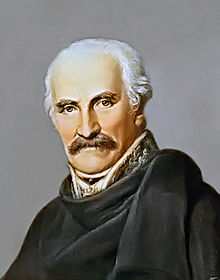- Coalition forces of the Napoleonic Wars
-
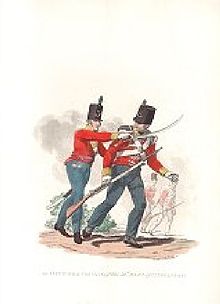 British 52nd light infantry regiment, early 1800s
British 52nd light infantry regiment, early 1800s
The Coalition Forces of the Napoleonic Wars were composed of Napoleon Bonaparte's enemies: the Austrian Empire, Kingdom of Prussia, Kingdom of Spain, Kingdom of Naples and Sicily, United Kingdom[1], Kingdom of Sardinia, Dutch Republic, Russian Empire, the Ottoman Empire, Kingdom of Portugal, Kingdom of Sweden, various Confederation of the Rhine and Italian states at differing times in the wars. Together at their height, the Coalition could field a formidable force of about 1,740,000 strong, a force the 1.1 million French soldiers would reckon with. These were the military manpower breakdowns of more active armies: Austria, 520,000; Britain, 320,000; Prussia, 300,000; and Russia, 600,000.
Contents
British Forces
Main article: British Army during the Napoleonic WarsThe British Army forces consisted of 320,000 troops at their height, a notable 2% of the entire British population at the time. Integral parts of the British army were the King's German Legion (18,000 men), the Brunswick troops and several other troops from France, Switzerland and the Netherlands.
Infantry
Gaining experience under the Duke of Wellington in the Peninsular War and forged into a disciplined, honed weapon of war, they advanced to become a very prominent force in the Napoleonic Wars. The redcoats, as they were called, principally employed tactics such as disciplined platoon fire and (sometimes) bayonet charges and saw much success through these methods.
These foot soldiers were typically equipped with the Tower pattern musket, or 'Brown Bess', whose individual inaccuracy was compensated for by the technique of mass firing by platoons.
Light infantry
See also: Light DivisionThe British and German elite light infantry hold a distinct advantage over their counterparts on the battlefield as they were equipped with Baker rifles. However this rifle compromises loading speed, a fact that put Napoleon Bonaparte off using them, therefore were the French voltigeurs equipped only with muskets. The advantage of the rifles were the great accuracy of the weapon, due to the grooved barrels. The soldiers were able to shoot and hit the opponent at distances, where no musket would have an effect. Also the light battalions were deployed in pairs of 2 soldiers, forming a skirmish curtain, fighting quite independently and using all cover they could find. These were new tactics, frowned on by more conservative officers, but very effective against enemy officers, who were often the first targets of the skirmishers.
Line infantry
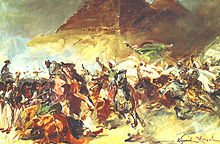 Mamluk cavalry charges French infantry square during the Battle of the Pyramids, painting by Wojciech Kossak .
Mamluk cavalry charges French infantry square during the Battle of the Pyramids, painting by Wojciech Kossak .
The line, column and square formations were the most recognized tactical formations in use during the Napoleonic Era.[2] Each of these formations has its own unique purpose in attacking or counter-attacking the enemy and no doubt played a large role in battlefield tactics. The line formation was the most favored amongst the British infantry. The line formation offered the maximum firepower to any enemy, about 1000 to 1500 bullets per minute [3]. Unlike the French favored column formation, the line formation enabled all muskets available to fire at the enemy and it also forms a wider front, as in contrast, only the few soldiers in the first rows of the column (about 60) were able to fire.[4] While the line formation may have seemed to be the best against infantry, they were not protected from the rear. A leash of the enemy's cavalry would send the frail lines into chaos and horrendous casualties. Therefore it was necessary, to form the line into a square, as soon as possible, when cavalry was approaching. The square was the best protection against cavalry, as no horse would go near a row of bayonets three (or more) deep. Only on very rare occasions were these squares destroyed, e.g. at the Battle of Salamanca three French squares were destroyed by the cavalry of the King's German Legion. The bayonet was primarily used to finish an action, already virtually decided by musketry opposing regiments when formed in line and charging with fixed bayonets, 'never' meet a struggle hand to hand and foot to foot; and this for the best possible reason, that one side turns and runs away as soon as the other comes close enough to do mischief[5].Thus the fear of the bayonet, rather than the bayonet itself was the deciding factor. One of the few battles were the bayonet was used extensively was the Battle of Fuentes de Onoro.
The British infantry pay rates ranged from 22 shillings 6 pence per day for a colonel to as low as 1 shilling per day for a private.
Cavalry
Britain's war effort against France was always hampered by a shortage of cavalry. Its lack of numbers accompanied by poor leadership and indiscipline wasted not only good opportunities but also lives. The cavalry consisted of a few important ranks. Each played a different role in ensuring the army was an effective and formidable war machine.
The British cavalry had developed a few crucial tactics in which to out-do these opponents. Against infantry the British had an idea of planning a cavalry charge just after the enemy's infantry volley. This would minimize the number of muskets available to shoot at the cavalry as the infantry would be busy reloading. The infantry square formation was the best formation designed to outmaneuver the cavalry.
- Household regiments - One of the distinct branches of British heavy cavalry. The Life Guards and the Royal Horse Guards were of little use during the early years of the Napoleonic Wars, but they certainly made up for tardiness with their heroics at the Battle of Waterloo.
- Heavy dragoons - The second branch of the British heavy cavalry. These mounted infantryman and heavily armed cavalrymen included seven regiments of Dragoon Guards and six of Dragoons. Being large men on large horses, the British heavy dragoons were used as shock troops in battle. They would throw themselves into the fray to bolster a weakening line, as at Waterloo, or smash through the enemy formations and rout the enemy. Dragoons occasionally fought on foot using carbines shorter versions of the infantry muskets.
- Light Dragoons - The skills required of light cavalry (patrolling, reconnaissance, and screening) had to be picked up while on active service in the Peninsular. The best of the British units was the King's German Legion, which performed excellent service in the Peninsula especially in the work with the light division for outpost work there was no cavalry equal to his German hussars[6] and made history by breaking French Infantry squares at Garcia Hernandez.
- Hussars - Hussars were introduced into the British army after 1806, when four Light Dragoon regiments, the 7th, 10th, 15th and 18th, were styled hussars, as well as the 3 regiments of hussars King's German Legion.
Artillery
Cannons
Britain had a small but highly effective artillery arm (the Royal Artillery) that was exceedingly well trained but suffered from light guns. British cannon barrels were brass, with the carriages, wheels, and timbers painted gray and metal pieces painted black. The basic guns were from three to six pounders, and the British found themselves at a distinct disadvantage against French cannons. In fact, the Duke of Wellington forbade his gunners to engage in counter-battery fire against the superior French weapons and ordered them to focus on firing at enemy troops. The artillery was divided in horse artillery and foot artillery. Each cannon was manned by five gunners.
The anti-personnel bias of British artillery was boosted by the invention of a fused spherical case-shot that was designed, by General Sir Henry Shrapnel, to explode over the heads of enemy troops and shower them with musketballs.
Ranges
Cannon Gun Type (caliber) Maximum (metres) Effective (metres) Firing Canister 3-pounder 1000 320–400 approx. 275 6-pounder 1100–1350 550–640 320–360 9-pounder 1550 725–825 410 Howitzer Gun Type (caliber) Maximum (metres) Effective (metres) Firing Canister 5.5-inch 1550 640 460 Rockets
Another newfound British invention was the Congreve Rocket, which was intended to shoot a barrage of 12-pounder explosives in the general direction of the enemy.
Unfortunately, the rockets were not very accurate and although they did see action in Iberia, as well as in Germany, Battle of the Goerhde and Battle of Leipzig, they were not viewed as being particularly effective. Mostly they effected a terror in the enemy troops, who were unfamiliar with this kind of weapon. The French thought in the beginning, that the rocket troops were lancers, as the firing device seemed in the distance to be a lance.
Commanders

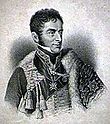
Duke of Wellington Sir Henry Paget 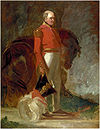

Sir Rowland Hill Sir John Moore - Arthur Wellesley, 1st Duke of Wellington
- Robert Craufurd
- Thomas Graham, 1st Baron Lynedoch
- Henry Paget, 1st Marquess of Anglesey
- Rowland Hill, 1st Viscount Hill
- Sir Isaac Brock
- Stapleton Cotton, 1st Viscount Combermere
- Sir Thomas Picton
- Sir John Moore
- William I of the Netherlands as Dutch Commander
- Sir Edward Pakenham
- John Le Marchant
- Colin Halkett
- Charles Alten
Allied forces
The tactics of the allied forces were at the beginning of the wars different from the British tactics. They tried to use e.g. the column. But as they almost all lost against the French, they had to change and develop their systems. They became more and more similar to the British systems, although with differences, so was the Prussian line three men deep, in contrast to the two men line of the British army.
Austrian Empire
See also: Austrian Empire#Foreign policyKingdom of Naples and Sicily
See also: Kingdom of NaplesCommanders included were:
- Karl Philipp, Prince of Schwarzenberg
- Archduke Charles, Duke of Teschen
- Karl Mack von Leiberich
- Archduke John of Austria
Kingdom of Portugal
The army of Portugal was in great need of modernization. Therefore quite a number of British officers joined the Portuguese army, rising in rank by that. They formed the army after the example of the British army and formed a force with great fighting spirit and skills. The caçadores were as effective as the British light infantry and fought side by side with their allies. The Portuguese units were attached to the British regiments, the Duke of Wellington being the commander of the joined forces.
Commanders included were:
- William Beresford
- Francisco de Paula Leite
Kingdom of Prussia
See also: Prussia#Napoleonic WarsCommanders included were:
- Gebhard Leberecht von Blücher
- Charles William Ferdinand, Duke of Brunswick
- Frederick Louis, Prince of Hohenlohe-Ingelfingen
Russian Empire
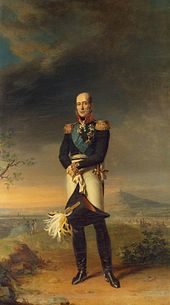 Portrait of Barclay de Tolly from the Military Gallery of the Winter Palace, by George Dawe.
Portrait of Barclay de Tolly from the Military Gallery of the Winter Palace, by George Dawe. Main article: French invasion of Russia
Main article: French invasion of RussiaCommanders included were:
- Michael Andreas Barclay de Tolly
- Mikhail Illarionovich Kutuzov
- Count Bennigsen
- Pyotr Bagration
- Peter Wittgenstein
Kingdom of Spain
 Francisco Javier Castaños
Francisco Javier Castaños
After the defeat of Spain and the deportation of the King and his family to France, the Spanish army in 1812 to 1814 was divided in several parts.
- The 1st army in Catalonia was dissolved by he French in 1811, but gathered again and was in 1813 under General Copons again 16,000 men strong.
- The 2nd army in Valencia was defeated and dissolved, but had gathered again in 1813 under general Elio and was then 30,000 men strong. it incorporated the former guerrilla troops of El Empecidano.
- The 3rd army in Murcia was in 1814 under the Prince of Anglona 21,000 men strong.
- The 4th army was under the command of the Duke of Wellington, between 46,000 men and 30,000 men strong.
- The 5th to 9th army were integrated into the 4th army.[7]
The Spanish troops in 1813 were about 160,000 men. Also very active were the Spanish guerilla troops, which were in 1812 the strongest forces Spanish forces.[8] They fought most of the time independently, but were also co-ordinated by the British. So was a guerilla force on the British right flank in the Battle of Fuentes de Onoro.
Commanders included were:
Kingdom of Sweden
See also: Treaty of KielSee also
References and notes
- ^ The only constant in each of the seven coalitions, the first of which was formed against the First French Republic
- ^ Infantry Tactics and Combat during the Napoleonic Wars ~ Part 3 ~
- ^ Haythornthwaite p.26
- ^ Haythornthwaite p.5
- ^ Haythornthwaite p.27
- ^ Crauford p.95
- ^ Chartrand p.4
- ^ Chartrand p.11
Sources
- Chartrand, René: Spanish Army of the Napoleonic Wars (3) 1812-1815 (German translation and excerpt) Osprey 2002 ISBN 84-8372-786-2
- Haythornthwaite, Philip: Weapons & Equipment of the Napoleonic Wars Arms and Armour 1996 ISBN 1-85409495-5
Further reading
- Crauford, Alexander H.: General Crauford and his light division (reprint Naval & Military Press 2006) ISBN 1-845740-13-0
External links
- Richard Moore. "The Napoleonic Guide". http://www.napoleonguide.com/. Retrieved December 3, 2005.
Categories:- Armies of Napoleonic Wars
Wikimedia Foundation. 2010.


